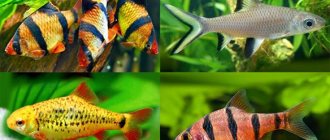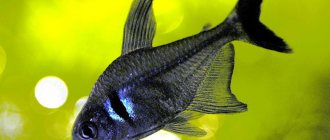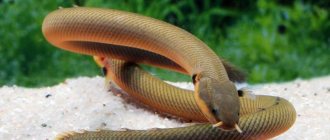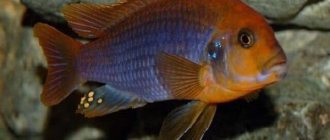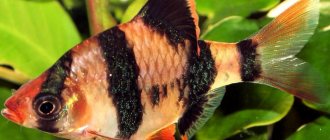Black Barbus, or black puntius (Pethia nigrofasciatus) is a common fish in the aquariums of our hobbyists. She loves sunny places in the water, and that there are many plants around, among which she can make a shelter for herself, since she is a shy fish. Any sudden movement near the aquarium may frighten her. For Barbus to feel good, there must be at least 7 of them in a flock, more are welcome.
Description
The body of the fish is painted in a rich shade of red and black. The body length of an adult is 6 cm. The body is flat with a large profile. Barbus's head is small and its tail is short. There are 3-4 vertical stripes on the body. All fins on the body are colored charcoal black. Young fish of this species are unattractively colored, but at the time of puberty they look magnificent.
Feeding
In nature, it feeds on detritus, which is basically everything it can find at the bottom - insects, algae, plants, invertebrates.
They rummage in the silt and fallen leaves that abundantly cover the river bottoms in Sri Lanka and most of their diet consists of plant components - algae and the remains of higher plants.
Based on this, it is important to give the black barb food high in fiber, otherwise it may tear off young shoots of plants. These can be flakes with spirulina, tablets or vegetables - cucumbers, zucchini, lettuce, spinach.
Protein foods are also eaten with pleasure, and you can feed all small species - bloodworms, daphnia, brine shrimp.
Sex difference
Many people do not know how to determine the gender of a fish (what a male and female look like). The difference can be seen at puberty, which occurs when the fish is one year old. The color of the male individual is brighter and at the time of spawning the black vertical stripes merge into a single black color of the body. And the head and chest have a red tint, attracting females. The length of a male can reach 6.5 cm. At the same time, females are 1 cm shorter than their partners, and therefore fish from the same brood can be distinguished due to their different sizes.
Possible diseases
The black barb is a fairly strong fish with a good immune system. But under poor living conditions and improper feeding, there is a risk of developing a number of serious diseases:
- rubella;
- fin rot;
- white skin (accompanied by significant paleness of color);
- ichthyophthyriosis.
All of these diseases are quite treatable. Having recovered, black barbs acquire stable immunity to them, eliminating the possibility of relapse. But at the same time, they become carriers of infection, which can lead to infection of other aquarium inhabitants.
A specific disease that exclusively affects representatives of this species is gill rot, which is manifested by damage to the circulatory system in the gills with their further disintegration. The first signs of pathology are lethargy and decreased activity of the fish. The black barb refuses food and strives to stay on the surface of the water layer for as long as possible due to difficulty in breathing.
There are practically no reactions to external stimuli. It is important to start therapy on time, when the first warning symptoms appear, because otherwise irreversible processes begin and the fish dies from constant oxygen deficiency. Gill rot is treated with medications. Before this, sick individuals should be moved to a separate tank.
Often, beginning aquarists are faced with the problem of fading color and a clear decrease in the activity of black barbs. According to experts, this may be due to excessively bright lighting, the lack of sufficient greenery and secluded places for shelter in the aquarium, and loneliness.
Under good keeping conditions, the average life expectancy of a black barb is about 5 years.
Maintenance and care
Keeping and caring for fish is not difficult even for beginner aquarium fish lovers. The need for one fish is calculated to be 5 liters. water and therefore an aquarium of at least 30 liters is required for a flock of 6 heads. Since this is a shy fish, it is necessary that the general aquarium have many plants among which the Barbus can hide. Water changes should be weekly, up to 25% of the total volume. Water filtration and aeration should be turned on for at least 9 hours a day. The water temperature is between 25-26 degrees Celsius. Hardness up to 20 degrees.
Barbus black
Barbus black
Order, family: carp.
Comfortable water temperature: 20 - 24°C.
Ph: 6.5-7.0.
Aggression: moderately aggressive 30%.
Compatibility of black barb: barb, gourami, parrot, catfish, thorns, tetras.
If you decide to get barbs, we recommend setting aside a separate aquarium for this purpose.
Description: Black barb lives in slow-flowing, heavily overgrown streams and rivers of Sri Lanka. It was first brought to Russia in 1954.
The black barb has an oval, elongated and laterally compressed body. The mouth is terminal, antennae are absent. The main body color is yellowish with 3-4 transverse stripes, the edges of large scales have a silvery (sometimes golden-greenish) tint. The first short stripe runs between the eyes, and the last marks the posterior edge of the caudal peduncle. The snout is reddish. During the spawning period, the body color of the fish changes: in the female, the stripes become more distinct, in the male, the front part of the body is painted dark red, the back part is black, with a greenish tint. The dorsal fin of the male is black, the anal fin is black with a red tint, and the caudal fin is dark. The female is paler and smaller than the male. The black barb grows up to 7 cm in length.
The fish is a very active, schooling and peaceful fish. The black barb kept in a group of 6-7 individuals. Gets along well with various types of fish, with the exception of fish with wide or long fins. It lives in the middle and lower layers of water.
To keep the black barb, you need a closed aquarium with a volume of at least 60 liters with dim, diffused lighting. It should have various shelters (snags, stones), thickets of plants and free space for swimming. The soil is small pebbles. Water parameters for proper maintenance of black barb: hardness up to 20°, pH 6.5-7.0, temperature 20 - 24°C. Filtration, strong aeration and weekly changes of up to 30% of the water volume are required. The black barb reaches sexual maturity at the age of 7-11 months.
barbus black
The black barb eats live, vegetable (algae, scalded lettuce, spinach and dandelion) and dry flake food. With a lack of plant food, the black barb begins to eat plants.
Feeding aquarium fish should be correct: balanced, varied. This fundamental rule is the key to the successful keeping of any fish, be it guppies or astronotuses. The article “How and how much to feed aquarium fish” talks about this in detail; it outlines the basic principles of the diet and feeding regime of the fish.
In this article, we note the most important thing - feeding fish should not be monotonous; the diet should include both dry food and live food. In addition, you need to take into account the gastronomic preferences of a particular fish and, depending on this, include in its diet food either with the highest protein content or, conversely, with plant ingredients.
Popular and popular food for fish, of course, is dry food. For example, you can constantly and everywhere find food on aquarium shelves - the leader of the Russian market; in fact, the range of food for this Tetra is included as individual food for a specific type of fish: for goldfish, for cichlids, for loricariids, guppies, labyrinths, arowanas, discus, etc. .d. Tetra has also developed specialized foods, for example, to enhance color, fortified, or for feeding fry. You can find out detailed information about all Tetra feeds on the company’s official website - here .
It should be noted that when purchasing any dry food, you should pay attention to the date of its manufacture and shelf life, try not to buy food in bulk, and also store the food in a closed state - this will help to avoid the development of pathogenic flora in it.
All of the above is just the fruit of observing this type of aquarium fish and collecting various information from owners and breeders. We would like to share with visitors not only information, but also live emotions that allow us to understand the world of aquariums more fully and subtly. Register at https://fanfishka.ru/forum/ , participate in discussions on the forum, create profile topics where you will talk about your pets in the first person and first-hand, describe their habits, behavioral features and content, and share with us your successes and joys, share your experiences and learn from the experiences of others. We are interested in every bit of your experience, every second of your joy, every awareness of a mistake, which makes it possible for your comrades to avoid the same mistake. The more of us there are, the more pure and transparent drops of goodness there are in the life and everyday life of our seven billion society.
Photo selection of black barb
Barbus black video
General information about barbs
Family Carp (Cyprinidae).
Barbs (genus Barbus) are spawning fish. There are several dozen varieties found in nature. Distributed in Africa, South and Southeast Asia. Most of them are small schooling moving fish, the size of which is 4-6 cm. Small barb fish are considered peaceful inhabitants of aquariums, but they can be aggressive to the point that they destroy other fish in the aquarium. In general, these are fast and nimble fish, constantly on the move, they are looking for something and catching up with each other. Suitable for aquarists who prefer active fish. It is not worth keeping them with sedentary neighbors, because... they will constantly disturb, tug, and create a stressful situation. Large barbs can compete even with aggressive aquarium inhabitants. Most of these species can be kept in aquariums of 50 liters or more. Barb fish feel good at fairly low temperatures of 20-24C. The composition of the water does not play a significant role; these fish are accustomed to living in running water. Therefore, it is advisable to create a flow in the aquarium using aeration. Small species are kept in a flock of 5-7 pieces. Their lifespan in an aquarium is usually 3-4 years. Large fish, such as the shark barb, are often kept singly or in pairs; they live much longer in captivity. The color of the soil should be dark, in this case the fish look brighter. Planting for these restless fish should not be very dense, with space for swimming, because... It is in open areas that fish show their active character. The presence of floating plants is optimal for them. There should also be separate, densely overgrown places that serve as shelter for them. Almost anything can be used as food for most aquarium barbs: live bloodworms, tubifex, daphnia, cyclops, frozen daphnia and bloodworms; various dry mixtures based on dried daphnia; granulated industrial feed. For adult fish, it is advisable to add plant components, otherwise these aquarium inhabitants can damage young shoots of plants.
Compatibility with other fish
Compatibility with other fish is possible, although there is an opinion that they live only with representatives of their own species. They also go well with:
- Catfish;
- Tetras;
- Gourami;
- Ternets.
True, Barbs are quite active fish and sometimes they become active by biting off the fins of other fish. First of all, so that the fish do not conflict with each other, there must be enough space in the aquarium for everyone and food must be provided without interruption.
Breeding
At home, breeding Black Barbus depends on its diet. Before spawning, the female and 2-3 males are placed in a spawning tank with a plant and intensively fed with live food. This will stimulate reproduction. A spawning tank is an aquarium whose volume will be at least 45 liters. It should not be exposed to direct rays of the sun, but only side rays. The water should have the same criteria as in a general aquarium. And its temperature should remain at +26 degrees.
The mating games themselves look as if one fish is vigorously chasing another. At such moments, the female lays up to 500 small eggs. After spawning, adults must leave the spawning area, as they are very voracious and can eat their own eggs. After a day, small worms begin to hatch from the eggs, which, with proper nutrition, will soon turn into beautiful individuals of the Black Barb. Barbs are ready to breed at 11 months.
Habitat in nature
The black barb lives in its homeland in Sri Lanka, where it was once often found in the tributaries and upper reaches of the Kelani and Nivala rivers.
In such rivers, as a rule, there are abundant plants, the current is weak, and the water is much cooler than in other tropical reservoirs.
In addition, the water is soft and acidic, and there is sand or fine gravel at the bottom. Detritus and algae form the basis of nutrition in nature.
Unfortunately, the population has decreased significantly due to unwise fishing for the needs of aquarists. Deforestation of habitats also played a role.
At one time the species was on the verge of extinction, but now the population has recovered slightly.
Now catching them in the wild is prohibited by law, and all individuals found on sale are artificially bred.
Moreover, with the help of hybridization it is possible to create new, brighter color variations.
Diseases
Diseases only appear when the fish are poorly maintained and the basic requirements for caring for the fish are not met. And although Barbus is a rather insensitive fish, it also gets sick in bad conditions:
- Fin rot;
- Ichthyophthyriasis;
- Rubella;
- White-skinned.
A fish, once ill, recovers, but remains a carrier of this disease for the rest of its life. A sick fish can be easily noticed by its lethargic behavior. She is taken away and treatment begins.

